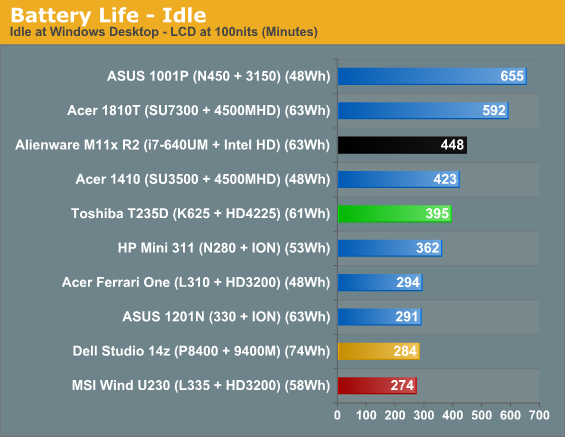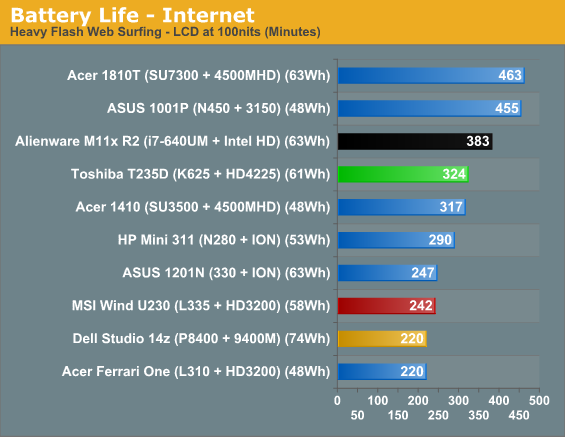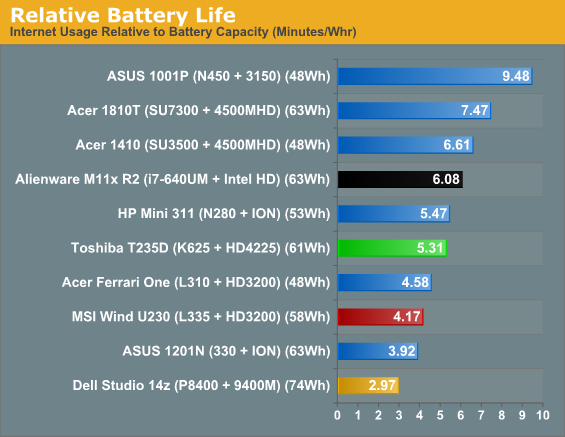Toshiba T235D: AMD's 2010 Ultrathin "Nile" Platform
by Jarred Walton on August 23, 2010 11:00 PM ESTAMD Nile: Improving Battery Life
We've railed on AMD's battery life in previous reviews, and rightly so. If you can't build a faster laptop than Intel, and pricing isn't significantly better, you need to at least offer comparable battery life. The T235D addresses all of these areas to varying degrees, but let's look at battery life specifically. Thankfully, Toshiba includes a larger-than-normal 61Wh battery with the T235D, which puts it in direct contention with the 63Wh batteries of the M11x and the Acer 1810T.




So, we're still not at the 8+ hours that CULV laptops get, but we're finally hitting 6.5 hours in our idle test and around 5.5 hours in our Internet test; you can even last long enough for nearly two full-length movies (just shy of four hours). For a thin and light laptop, that's definitely acceptable. If we factor in battery capacities, the Acer 1810T is still our leader (at least, our leader after Atom), with 15% to 45% more life per Wh than the T235D. Switch to the M11x R2 and it's a lot closer: the two contestants are tied in x264 playback, while the M11x leads by 10% to 15% in the idle and internet results.
As for the old Congo platform, if we compare based on relative battery life (i.e. factoring in battery capacity), the T235D beats the smaller Ferrari One by 6% to 24%. The difference between the T235D and the U230 is even greater: 27% higher Internet life and 37% more Idle/x264 run-time. All it would take is something like the ASUS UL series' 84Wh batteries and the T235D could reach around nine hours of mobility.
One final note is that the battery in the T235D says it's a 61Wh model in one place, but it also lists a voltage of 10.8V and 5300mAh. Multiply those out to get the wattage and it looks like the battery would be better classified as a 57Wh 6-cell, which would improve our relative battery life measurement from 5.31 up to 5.68. (Oddly enough, the online specs list the T235D as coming with a 48Wh battery; we're not sure if we got a "special" battery or if the spec pages are simply wrong, but hopefully it's the latter.) Of course, battery capacities are a bit tricky—I know I have some 2500mAh 1.2V AA Energizer rechargeable batteries that suck compared to some equivalently rated 2500mAh Eneloop rechargeables. Without a lot more detail on the internal workings of the batteries all we have to go off are the manufacturer ratings on the back, as well as our real-world battery life test results.










34 Comments
View All Comments
mczak - Wednesday, August 25, 2010 - link
per-clock performance of HD3200 and HD4200 is pretty much the same. The difference here (aside possibly from clock - not sure what clock the hd3200 used in the other notebooks were running at) is the platform. Most notably the HT speed, which was limited to HT-800 for Congo platform instead of HT1600 (for the K625). This basically halves the memory bandwidth available to the GPU and as you can guess this has a pretty disastrous effect on performance. Other differences are possible as well (e.g. different sideport memory), I believe some congo designs also ran their (ddr2) memory at a very low clock which could further lower scores though unless it was single channel it shouldn't make much of a difference since the HT-800 limits available gpu memory bandwidth still more. Well it could be a combination of slow memory and slow HT but whatever the case it's a bandwidth problem not architectural differences which make the HD3200 and HD4200 perform differently (unless you had an app which would use DX10.1 features).Hyperion1400 - Tuesday, August 24, 2010 - link
"Of course, battery capacities are a bit tricky—I know I have some 2500mAh 1.2V AA Energizer rechargeable batteries that suck compared to some equivalently rated 2500mAh Eneloop rechargeables"IxV gets you rated output(max power output assuming 0 ohm resistance). The only way to know the capacity of a battery is to rely on the manufacturer's word or to test the battery yourself.
Computer Bottleneck - Tuesday, August 24, 2010 - link
I think it is really interesting that older 45nm Intel's like SU7300 score better in battery tests than 32nm Arrandale i7-640um (found in Alienware M11 R2).Does this have anything to do with differences in peripherals (hard-drive, LCD, etc)? I noticed the Alienware has a 7200 rpm drive whereas the Acer Timeline 1810 has a 520 rpm drive. Or is the battery life difference related more to other factors? (I was expecting 32nm to definitely pull away from 45nm all things being equal).
JarredWalton - Tuesday, August 24, 2010 - link
I don't think most of the components make much of a difference. M11x isn't the most power-friendly implementation of Arrandale ULV, though, so we'll see how the ASUS UL80Jt stacks up next week. In general, though, the IGP in Arrandale is far more potent than the old GMA 4500MHD, and perhaps that's part of the difference.Intel specs the Arrandale ULV chips at 18W, which includes graphics. The CULV stuff was 10W, but I don't have a clear number on the chipset+IGP. It would appear that the chipset tops out at around 3W-5W for the IGP based on my testing here:
http://www.anandtech.com/show/2932/intel-core-2-cu...
Idle power draw on CULV may also be better, for whatever reason. Maybe 32nm has higher leakage, or it's just the number of transistors. I keep thinking the next 32nm parts from Intel will probably show much better power numbers, as this is really their first 32nm part. We'll see later this year with Sandy Bridge I guess.
strikeback03 - Tuesday, August 24, 2010 - link
All the testing with any Arrandale (ULV or not) has shown battery life not really improved from the later C2D processors, correct? Maybe there will be an improved stepping at some point.Computer Bottleneck - Wednesday, August 25, 2010 - link
Good point about Arrandale ULV possibly having higher leakage at idle. Maybe this is because i7-640um needs to be built on higher power wafers in order to hit the 2+ Ghz turbo speeds?Kishkumen - Tuesday, August 24, 2010 - link
As usual, the display just kills it all for me. A fine review, I just wish these laptop manufactures would throw us a freakin bone when it comes to some better displays. They're not doing themselves any favors with my pocket book anyway.Taft12 - Tuesday, August 24, 2010 - link
If you're referring to 1366x768, I fully agree!!Dell doesn't allow you to customize the screen nearly as much as they used to. Come on already, I am not paying over $600 for a laptop with that screen resolution!
The Crying Man - Tuesday, August 24, 2010 - link
Nice review. Is there any in the works with the N930 paired with an HD 5650? I have the dv6, but I'm just curious where it falls compared to all the other review laptops.JarredWalton - Tuesday, August 24, 2010 - link
I've got a P920 with 5650 review coming, but I do wish the CPU were faster. It's the Toshiba A665D... except the A665D is now discontinued and so my replacement system is the A660D. It's the same notebook but with a 7200RPM HDD AFAICT. Should have that up in the next week or so.